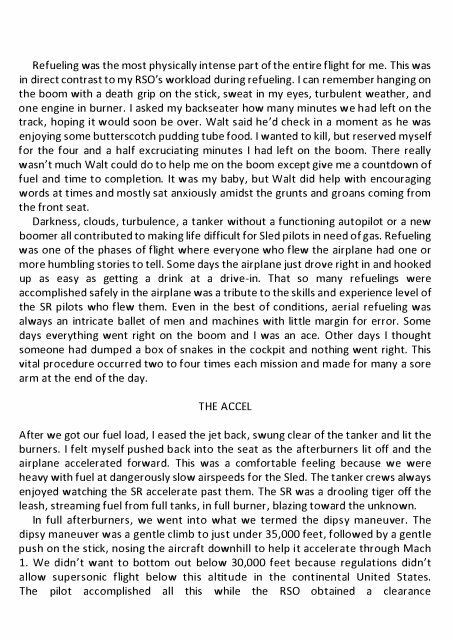Create successful ePaper yourself
Turn your PDF publications into a flip-book with our unique Google optimized e-Paper software.
Refueling was the most physically intense part of the entire flight for me. This was<br />
in direct contrast to my RSO's workload during refueling. I can remember hanging on<br />
the boom with a death grip on the stick, sweat in my eyes, turbulent weather, and<br />
one engine in burner. I asked my backseater how many minutes we had left on the<br />
track, hoping it would soon be over. Walt said he'd check in a moment as he was<br />
enjoying some butterscotch pudding tube food. I wanted to kill, but reserved myself<br />
for the four and a half excruciating minutes I had left on the boom. There really<br />
wasn't much Walt could do to help me on the boom except give me a countdown of<br />
fuel and time to completion. It was my baby, but Walt did help with encouraging<br />
words at times and mostly sat anxiously amidst the grunts and groans coming from<br />
the front seat.<br />
Darkness, clouds, turbulence, a tanker without a functioning autopilot or a new<br />
boomer all contributed to making life difficult for <strong>Sled</strong> pilots in need of gas. Refueling<br />
was one of the phases of flight where everyone who flew the airplane had one or<br />
more humbling stories to tell. Some days the airplane just drove right in and hooked<br />
up as easy as getting a drink at a drive-in. That so many refuelings were<br />
accomplished safely in the airplane was a tribute to the skills and experience level of<br />
the SR pilots who flew them. Even in the best of conditions, aerial refueling was<br />
always an intricate ballet of men and machines with little margin for error. Some<br />
days everything went right on the boom and I was an ace. Other days I thought<br />
someone had dumped a box of snakes in the cockpit and nothing went right. This<br />
vital procedure occurred two to four times each mission and made for many a sore<br />
arm at the end of the day.<br />
THE ACCEL<br />
After we got our fuel load, I eased the jet back, swung clear of the tanker and lit the<br />
burners. I felt myself pushed back into the seat as the afterburners lit off and the<br />
airplane accelerated forward. This was a comfortable feeling because we were<br />
heavy with fuel at dangerously slow airspeeds for the <strong>Sled</strong>. The tanker crews always<br />
enjoyed watching the SR accelerate past them. The SR was a drooling tiger off the<br />
leash, streaming fuel from full tanks, in full burner, blazing toward the unknown.<br />
In full afterburners, we went into what we termed the dipsy maneuver. The<br />
dipsy maneuver was a gentle climb to just under 35,000 feet, followed by a gentle<br />
push on the stick, nosing the aircraft downhill to help it accelerate through Mach<br />
1. We didn't want to bottom out below 30,000 feet because regulations didn't<br />
allow supersonic flight below this altitude in the continental United States.<br />
The pilot accomplished all this while the RSO obtained a clearance


